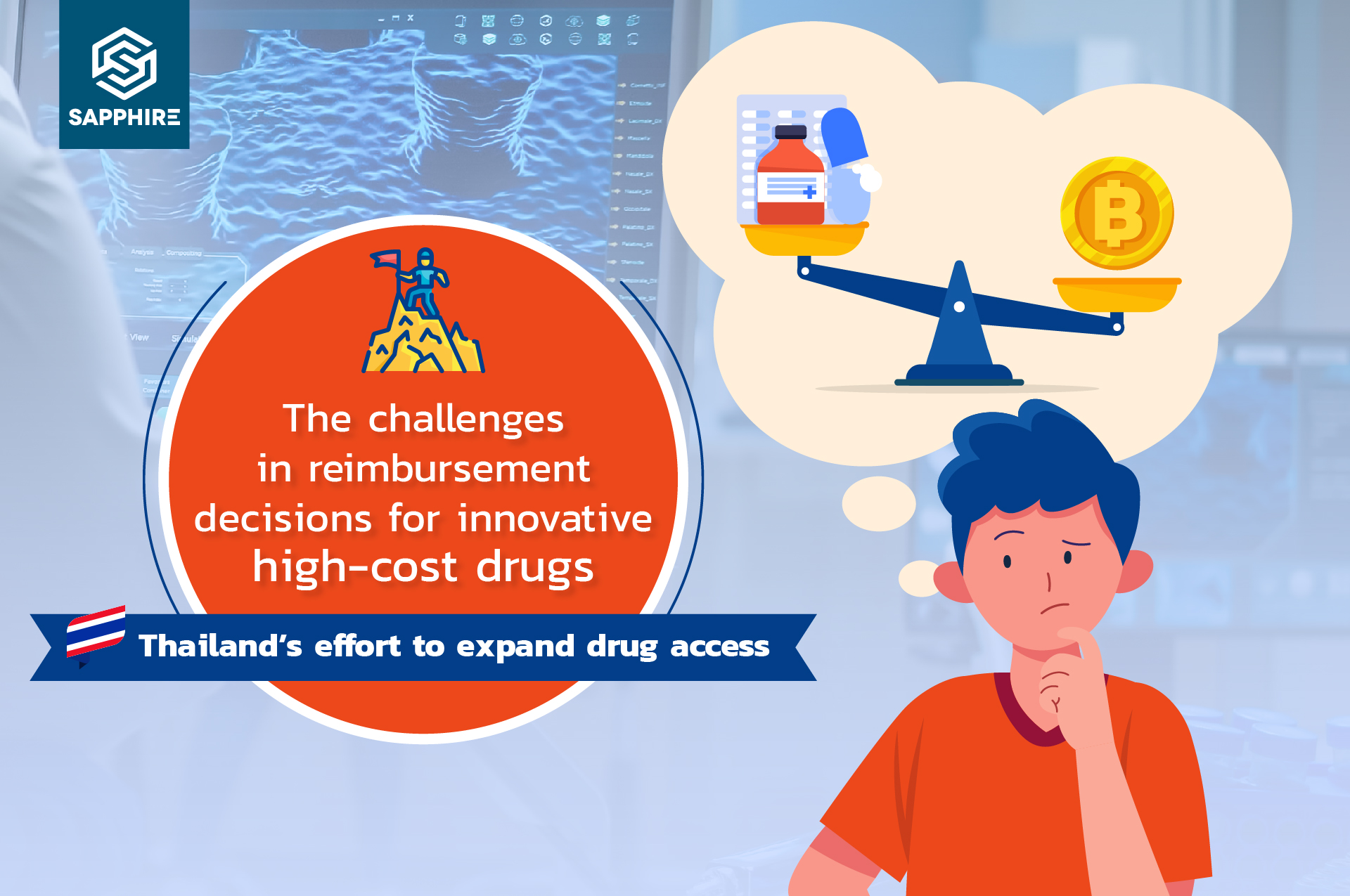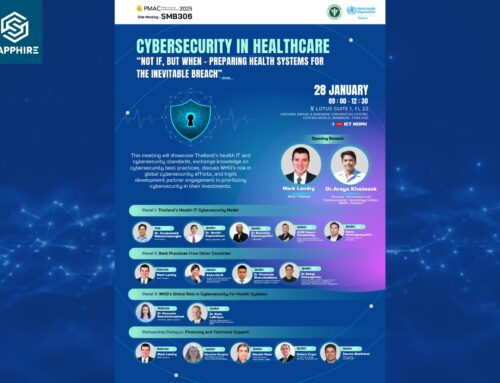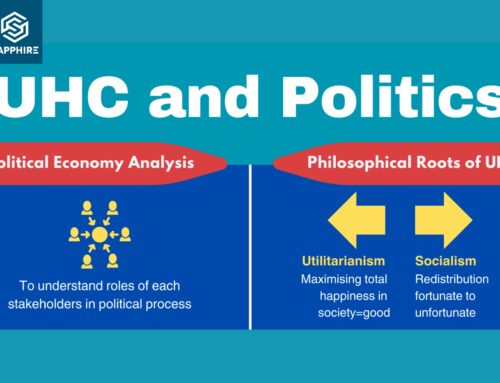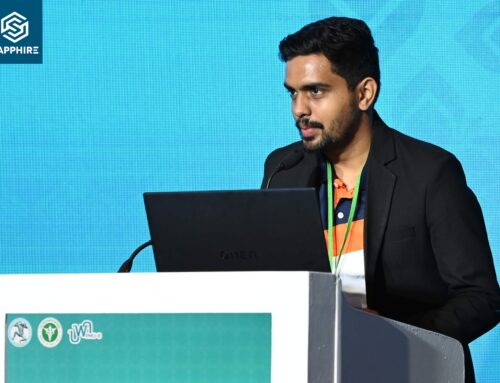
The decision-making challenge for reimbursing costly innovative drugs
Health technology assessment (HTA) is a multi-disciplinary approach crucial to the decision-making framework for drug reimbursements. It gives evidence of the drug’s cost-effectiveness and affordability to help policymakers decide what medicines to reimburse through the national health insurance policies under a finite budget for health.
Today, the rise of innovative drugs often used for cancer or rare diseases poses new challenges to existing frameworks. Significant research and development investments and the lack of competitors make these drugs very expensive. Especially for rare diseases, the uncertainty due to limited patient data, the lack of alternative treatments, and their high cost make it difficult to assess them using traditional HTA methodologies[1].
To ensure patients can access these costly but often life-saving drugs, Thailand is exploring new ways to recommend reimbursement under the National List of Essential Medicines.
Thailand’s existing reimbursement framework
An often-used metric in HTA is the willingness to pay (WTP), which is how much payers are willing to pay for a quality-adjusted life year (QALY). This threshold is compared with a drug’s incremental cost-effectiveness ratio (ICER), measured in cost per QALY. Drugs with an ICER lower than WTP are more likely to be reimbursed.
Thailand’s WTP is at 160,000 baht per QALY[2]. Yet, it does not mean they never funded medicines exceeding the WTP. For example, Thailand reimbursed Imiglucerase for Gaucher disease Type 1 because it was lifesaving without an overwhelming budget impact due to the disease’s rarity[3]. However, examples like this are not common, and many drugs are more expensive than Imiglucerase.
In the face of the growing innovation, public demand, and equity concerns, the existing framework may not adequately support consistent and timely funding decisions to give access to innovative drugs.
To explore solutions, the National Health Security Office (NHSO), which manages the Universal Coverage Scheme (UCS) in Thailand, established a task force to deliberate on this issue and provide recommendations. It commissioned the Health Intervention and Technology Assessment Program (HITAP), with the support of the Health Systems Research Institute (HSRI), to conduct a study to inform the policy process to advise on a reimbursement framework for high-cost medicines, which involves understanding the methods and systems for reimbursing high-cost drugs in Thailand and learning from the experiences of other countries such as England, Australia, Canada, South Korea, and Malaysia.
Learning from international experiences
Some higher-income countries have attempted new ways to expand drug access. They have moved beyond the WTP threshold and adopted other criteria to assess high-cost medicines when they have the potential to offer ‘significant’ health benefits. These high-cost drugs are often managed under separate funds apart from their national formulary funds.
In England, the National Health Service (NHS) is legally obliged to fund drugs recommended by the National Institute for Health and Care Excellence (NICE) following their HTA. Usually, NICE would not recommend drugs with an ICER exceeding £30,000 per QALY[4]. But, when a drug is deemed life-saving or can improve the quality of life in those with chronic and disabling rare diseases, a higher threshold of £300,000 per QALY is used to permit access[5].
Some countries do not even have an explicit WTP for making funding decisions for high-cost drugs. In Australia, cost-effectiveness evidence for drugs is submitted to the Pharmaceutical Benefits Advisory Committee (PBAC) for funding through the Pharmaceutical Benefits Scheme (PBS). When the PBS rejects a lifesaving drug due to its lack of cost-effectiveness, it is submitted for funding through the Life-Saving Drug Program (LSDP)[6]. Thus, it can be said that the LSDP is funding cost-ineffective drugs only.
To manage the risk of funding high-cost drugs without strong evidence of effectiveness, countries may allow access with the condition of further data collection and analysis.
For example, England’s Cancer Drug Fund (CDF) will fund cancer drugs with ‘plausible potential’ to satisfy routine commissioning criteria, but significant clinical uncertainty still exists[7]. Within two years of funding, more evidence would be collected and analyzed for a decision to terminate the financing of such a drug or to fund it through routine commissioning.
Australia also collects patient-level data on LSDP drugs, not only to assess clinical effectiveness but also to control inappropriate prescribing.
The stipulation of further data collection is often referenced in managed entry agreements (MEA). These are contracts with conditions between the payer and the pharmaceutical manufacturers, often used to negotiate for lower prices when the drugs have clinical uncertainties.
From our initial findings, MEAs are used extensively to expand access to costly drugs.
As a middle-income country, Thailand may not have the financial leverage to raise the threshold to the same extent as England and, given the policy context, may not “disregard” the threshold altogether like Australia’s LSDP. However, based on international experiences, adopting other decision criteria so that when drugs meet certain conditions, such as having lifesaving quality and utilizing MEAs for price negotiation, may be potential future directions for Thailand.
HTA shall remain crucial for making reimbursement decisions
The high-cost drug project is still in the early phases, and it is too soon to say what Thailand’s reimbursement framework will look like in the future. However, we recommend that HTA remain central to this decision-making framework. Ethical, social and other considerations will also play a role within this framework.
Conducting HTA to inform policy on medicine has been feasible and beneficial since Thailand introduced universal health coverage twenty years ago. Given the trend for higher health spending and the growth of innovative high-cost drugs, HTA can support the government in making wise and economically responsible reimbursement decisions.
To our knowledge, no other low- or middle-income country has established a process for reimbursing innovative high-cost drugs. These results can support researchers, HTA agencies, and policymakers in similar settings in making health policy decisions.
The intent to reimburse innovative high-cost drugs demonstrates a commitment to improving the existing health access. This is a turning point in Thailand’s healthcare system and will be a means to adapt to the changing landscape in the health sector.
References
[1] Drugs for Rare Diseases: A Review of National and International Health Technology Assessment Agencies and Public Payers’ Decision-Making Processes [Internet]. 2020 [cited 2022 Aug 16]. (Canadian Agency for Drugs and Technologies in Health). Available from: https://www.cadth.ca/drugs-rare-diseases-review-national-and-international-health-technology-assessment-agencies-and#:~:text=CADTH%20does%20not%20have%20a,exceptional%20cases%20such%20as%20DRDs.
[2] Thavorncharoensap M, Sompitak S, Doungthipsirikul S. What is the value of a Quality-Adjusted Life Year and how much is it? [Internet]. 2015 Jul [cited 2022 Aug 16]. (Health Intervention and Technology Assessment Program (HITAP)). Available from: https://www.hitap.net/wp-content/uploads/2014/12/PB_20-WTP-Eng-Final-for-web.pdf
[3] Teerawattananon Y, Tritasavit N, Suchonwanich N, Kingkaew P. The use of economic evaluation for guiding the pharmaceutical reimbursement list in Thailand. 2014 [cited 2022 Aug 16];108(7):397–404. Available from: doi: 10.1016/j.zefq.2014.06.017
[4] Dillon SA. Carrying NICE over the threshold | Blog | News [Internet]. NICE; 2015 [cited 2022 Aug 16]. (NICE). Available from: https://www.nice.org.uk/news/blog/carrying-nice-over-the-threshold
[5] National Institute for Health and Care Excellence. Interim Process and Methods of the Highly Specialised Technologies Programme Updated to reflect 2017 changes [Internet]. 2017. (National Institute for Health and Care Excellence). Available from: https://www.nice.org.uk/media/default/about/what-we-do/nice-guidance/nice-highly-specialised-technologies-guidance/hst-interim-methods-process-guide-may-17.pdf
[6] Life Saving Drug Program. Procedure guidance for medicines funded through the Life Saving Drugs Program (LSDP) [Internet]. 2018. (Life Saving Drug Program). Available from: https://www.health.gov.au/sites/default/files/documents/2021/11/procedure-guidance-for-medicines-funded-through-the-life-saving-drugs-program-lsdp.pdf
[7] NHS England. Appraisal and Funding of Cancer Drugs from July 2016 (including the new Cancer Drugs Fund) A new deal for patients, taxpayers and industry [Internet]. 2016. Available from: https://www.england.nhs.uk/wp-content/uploads/2013/04/cdf-sop.pdf



